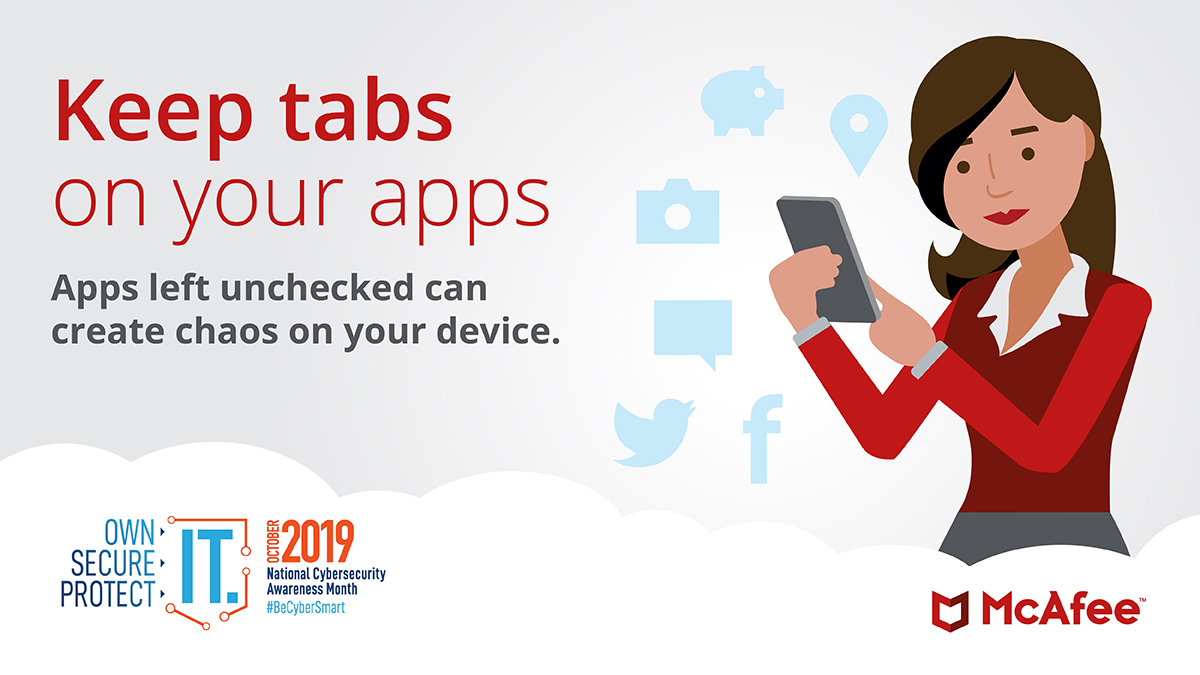
 While we talk about online safety each week on this blog, October is National Cybersecurity Awareness Month (NCSAM), a time to come together and turn up the volume on the digital safety and security conversation worldwide.
While we talk about online safety each week on this blog, October is National Cybersecurity Awareness Month (NCSAM), a time to come together and turn up the volume on the digital safety and security conversation worldwide.
To kick off that effort, here’s a comprehensive Device and App Safety Guide to give your family quick ways to boost safety and security.
Device Safety Tips
- Update devices. Updates play a critical role in protecting family devices from hackers and malware, so check for updates and install promptly.
- Disable geotagging. To keep photo data private, turn off geotagging, which is a code that embeds location information into digital photos.
- Turn off location services. To safeguard personal activity from apps, turn off location services on all devices and within the app.
- Review phone records. Monitor your child’s cell phone records for unknown numbers or excessive late-night texting or calls.
- Lock devices. Most every phone comes with a passcode, facial, or fingerprint lock. Make locking devices a habit and don’t share passcodes with friends.
- Add ICE to contacts. Make sure to put a parent’s name followed by ICE (in case of emergency) into each child’s contact list.
- Back up data. To secure family photos and prevent data loss due to malware, viruses, or theft, regularly back up family data.
- Use strong passwords. Passwords should be more than eight characters in length and contain a mix of capital and lower case letters and at least one numeric or non-alphabetical character. Also, use two-factor authentication whenever possible.
- Stop spying. Adopting healthy online habits takes a full-court family press, so choose to equip over spying. Talk candidly about online risks, solutions, family ground rules, and consequences. If you monitor devices, make sure your child understands why.
- Share wisely. Discuss the risks of sharing photos online with your kids and the effect it has on reputation now and in the future.
- Protect your devices. Add an extra layer of protection to family devices with anti-virus and malware protection and consider content filtering.
- Secure IoT devices. IoT devices such as smart TVs, toys, smart speakers, and wearables are also part of the devices families need to safeguard. Configure privacy settings, read product reviews, secure your router, use a firewall, and use strong passwords at all connection points.
App Safety Tips
- Evaluate apps. Apps have been known to put malware on devices, spy, grab data illegally, and track location and purchasing data without permission. Check app reviews for potential dangers and respect app age requirements.

- Max privacy settings. Always choose the least amount of data-sharing possible within every app and make app profiles private.
- Explore apps together. Learn about your child’s favorite apps, what the risks are, and how to adjust app settings to make them as safe as possible. Look at the apps on your child’s phone. Also, ask your child questions about his or her favorite apps and download and explore the app yourself.
- Understand app cultures. Some of the most popular social networking apps can also contain inappropriate content that promotes pornography, hate, racism, violence, cruelty, self-harm, or even terrorism.
- Monitor gaming. Many games allow real-time in-game messaging. Players can chat using text, audio, and video, which presents the same potential safety concerns as other social and messaging apps.
- Discuss app risks. New, popular apps come out every week. Discuss risks such as anonymous bullying, inappropriate content, sexting, fake profiles, and data stealing.
- Avoid anonymous apps. Dozens of apps allow users to create anonymous profiles. Avoid these apps and the inherent cyberbullying risks they pose.
- Limit your digital circle. Only accept friend requests from people you know. And remember, “friends” aren’t always who they say they are. Review and reduce your friend list regularly.
- Monitor in-app purchases. It’s easy for kids to go overboard with in-app purchases, especially on gaming apps.
Our biggest tip? Keep on talking. Talk about the risks inherent to the internet. Talk about personal situations that arise. Talk about mistakes. Nurturing honest, ongoing family dialogue takes time and effort but the payoff is knowing your kids can handle any situation they encounter online.
Stay tuned throughout October for more NCSAM highlights and information designed to help you keep your family safe and secure in the online world.
The post Device & App Safety Guide for Families appeared first on McAfee Blogs.
Premium Domain Names – transcom.uk
Transcom ISP – The UK’s Best Business ISP
DoubleCheck any website at doublecheck.uk